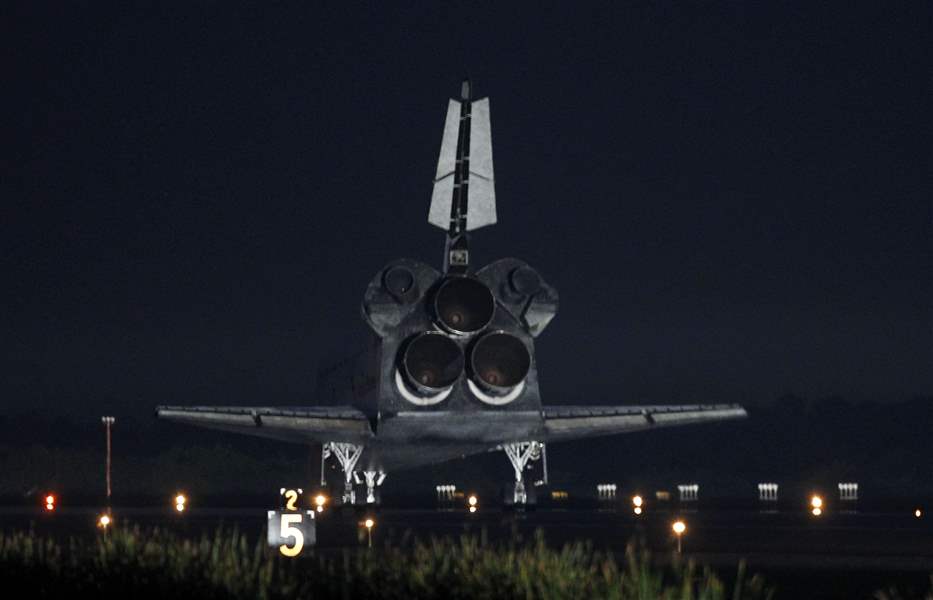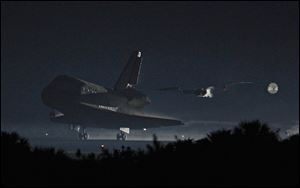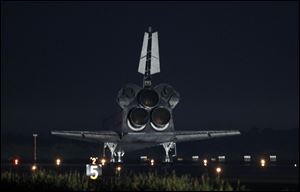
Atlantis lands, ending 30-year shuttle era
7/21/2011
Space Shuttle Atlantis comes to a complete stop at the Kennedy Space Center landing strip.
Terry Renna / AP

Space shuttle Atlantis lands Thursday at the Kennedy Space Center in Cape Canaveral, Fla..
CAPE CANAVERAL, Fla. — Atlantis and four astronauts returned from the International Space Station in triumph Thursday, bringing an end to NASA's 30-year shuttle journey with one last, rousing touchdown that drew cheers and tears.
Thousands gathered near the landing strip and packed Kennedy Space Center, and countless others watched from afar, as NASA's longest-running spaceflight program came to a close.
"After serving the world for over 30 years, the space shuttle's earned its place in history. And it's come to a final stop," commander Christopher Ferguson radioed after a ghostlike Atlantis glided through the twilight.
"Job well done, America," replied Mission Control.
With the space shuttles retiring to museums, it will be another three to five years at best before Americans are launched again from U.S. soil, as private companies gear up to seize the Earth-to-orbit-and-back baton from NASA.
The long-term future for American space exploration is just as hazy, a huge concern for many at NASA and all those losing their jobs because of the shuttle's end. Asteroids and Mars are the destinations of choice, yet NASA has yet to settle on a rocket design to get astronauts there.
Thursday, though, belonged to Atlantis and its crew: Ferguson, co-pilot Douglas Hurley, Rex Walheim and Sandra Magnus, who completed a successful space station resupply mission.
Atlantis touched down at 5:57 a.m., with "wheels stop" less than a minute later.
"The space shuttle has changed the way we view the world and it's changed the way we view our universe," Ferguson radioed from Atlantis. "There's a lot of emotion today, but one thing's indisputable. America's not going to stop exploring.
"Thank you Columbia, Challenger, Discovery, Endeavour, and our ship Atlantis, thank you for protecting us and bringing this program to such a fitting end."

Space Shuttle Atlantis comes to a complete stop at the Kennedy Space Center landing strip.
For the landing, there wasn't nearly the hoopla that surrounded Atlantis' launch on July 8 — when an estimated 1 million packed the Cape Canaveral area — because of the hour and lack of spectacle. The darkness robbed virtually all views of the approaching shuttle, and made it more of a NASA family affair.
Atlantis was greeted with cheers, whistles and shouts from the record 2,000 who had gathered near the runway — astronauts' families and friends, as well as shuttle managers and NASA brass. Soon, the sun was up and provided a splendid view. Within an hour, Ferguson and his crew were out on the runway and swarmed by well-wishers.
"The things that we've done have set us up for exploration of the future," said NASA Administrator Charles Bolden Jr., a former shuttle commander. "But I don't want to talk about that right now. I just want to salute this crew, welcome them home."
Nine hundred miles away, flight director Tony Ceccacci, who presided over Atlantis' safe return, choked up while signing off from shuttle Mission Control in Houston.
"The work done in this room, in this building, will never again be duplicated," he told his team of flight controllers.
At those words, dozens of past and present flight controllers quickly streamed into the room, embracing one another and snapping pictures while keeping their tears, if not their emotions, in check.
But on the landing strip in Florida, flight director Mike Leinbach said the tears flowed. He himself was awash with emotion as he took in "the beauty of the vehicle," snapped pictures and posed for pictures at workers' requests, some of whom face layoffs.
"I saw grown men and grown women crying today — tears of joy to be sure," Leinbach told reporters. "Human emotions came out on the runway today, and you couldn't suppress them."
Born with Columbia in 1981, the shuttle was NASA's longest-running space exploration program.
The five shuttles launched, saved and revitalized the Hubble Space Telescope; built the space station, the world's largest orbiting structure; and opened the final frontier to women, minorities, schoolteachers, even a prince. The first American to orbit the Earth, John Glenn, became the oldest person ever in space, thanks to the shuttle. He was 77 at the time; he turned 90 this week.
"I haven't cried yet, but it is extremely emotional," said Karl Ronstrom, a photographer who helps with an astronaut scholarship fund. He witnessed the first shuttle launch as a teenager and watched the last shuttle landing as a middle-aged man.
It was truly a homecoming for Atlantis, which first soared in 1985. The next-to-youngest in NASA's fleet will remain at Kennedy Space Center as a museum display.
This grand finale came 50 years to the day that Gus Grissom became the second American in space, just a half-year ahead of Glenn.
Atlantis — the last of NASA's three surviving shuttles to retire — performed as admirably during descent as it did throughout the 13-day flight. A full year's worth of food and other supplies were dropped off at the space station, just in case the upcoming commercial deliveries get delayed. The international partners — Russia, Europe, Japan — will carry the load in the meantime.
It felt like a two-month mission crammed into 13 days, the shuttle astronauts said, and they worked from dawn to dusk to make up for their small crew size. They said they choked up at times during the flight, whenever they paused and thought about the big picture.
It was the 135th mission for the space shuttle fleet, which altogether flew 542 million miles and circled Earth 21,152 times over the past three decades. The five shuttles carried 355 people from 16 countries and, altogether, spent 1,333 days in space — almost four years.
Two of the shuttles — Challenger and Columbia — were destroyed, one at launch, the other during the ride home. Fourteen lives were lost. Yet each time, the shuttle program persevered and came back to fly again.
The decision to cease shuttle flight was made seven years ago, barely a year after the Columbia tragedy. President Barack Obama nixed President George W. Bush's lunar goals, however, opting instead for astronaut expeditions to an asteroid and Mars.
Last-ditch appeals to keep shuttles flying by such NASA legends as Apollo 11's Neil Armstrong and Mission Control founder Christopher Kraft landed flat.
It comes down to money.
NASA is sacrificing the shuttles, according to the program manager, so it can get out of low-Earth orbit and get to points beyond. The first stop under Obama's plan is an asteroid by 2025; next comes Mars in the mid-2030s.
Private companies have been tapped to take over cargo hauls and astronaut rides to the space station, which is expected to carry on for at least another decade. The first commercial supply run is expected late this year, with Space Exploration Technologies Corp. launching its own rocket and spacecraft from Cape Canaveral.
None of these private spacecraft, however, will have the hauling capability of NASA's shuttles; their payload bays stretch 60 feet long and 15 feet across, and hoisted megaton observatories like Hubble. Much of the nearly 1 million pounds of space station was carried to orbit by space shuttles.
Astronaut trips by the commercial competitors will take years to achieve.
SpaceX maintains it can get people to the space station within three years of getting the all-clear from NASA. Station managers expect it to be more like five years. Some skeptics say it could be 10 years before Americans are launched again from U.S. soil.
An American flag that flew on the first shuttle flight and returned to orbit aboard Atlantis, is now at the space station. The first company to get astronauts there will claim the flag as a prize.
Until then, NASA astronauts will continue to hitch rides to the space station on Russian Soyuz spacecraft — for tens of millions of dollars per seat.
The space station, orbiting nearly 250 miles up, was visible from the launch site just before Atlantis returned. NASA's challenge, said space operations chief Bill Gerstenmaier, is "how do you make that little white dot real, that's as exciting as a launch ... or the landing that you saw nine minutes later?"
Thousands of layoffs are coming as early as Friday — on top of thousands of shuttle jobs already lost. As a thank you, NASA parked Atlantis outside its hangar, so workers could gather round and say goodbye to one another.
Hundreds stood in the midday heat, waving U.S. flags and paper fans, and photographing the shuttle.
Angie Buffaloe shed tears; three colleagues in her engineering office lose their jobs Friday.
"I spend more time with these guys than I do with my family," Buffaloe, a 22-year space center worker, said at the gathering. "We've been through everything: divorce, sick children, grandchildren. They've been there. We've shared life together ... and now their last day is today."
After months of decommissioning, Atlantis will be placed on public display at the Kennedy Space Center Visitors Complex; its debut is targeted for summer 2013. Discovery, the first to retire in March, will head to a Smithsonian hangar in Virginia. Endeavour, which returned from the space station on June 1, will go to the California Science Center in Los Angeles.
Ferguson said the space shuttles will long continue to inspire.
"I want that picture of a young 6-year-old boy looking up at a space shuttle in a museum and saying, 'Daddy, I want to do something like that when I grow up.' "
___
Online:
NASA: http://www.nasa.gov/shuttle
___
Online:
